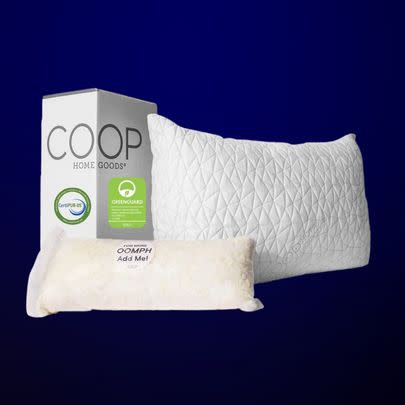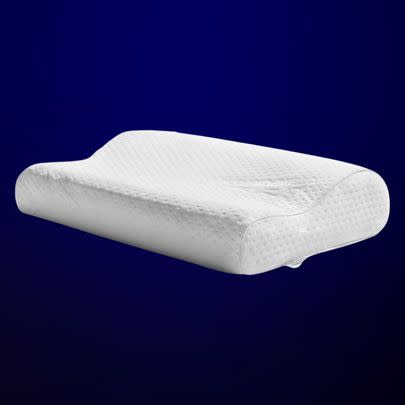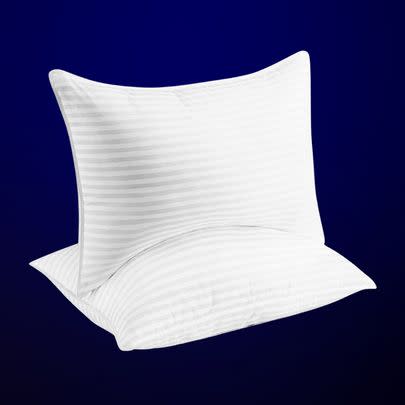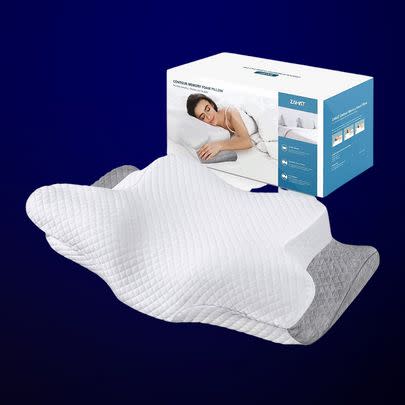How To Change Your Default Sleeping Position To A New One
You’ve been sleeping on your side for years. Is it possible to switch to sleeping on your back? Or what if you’re an avid back sleeper with a newfound reason to lie in bed on your side? Is making that change doable?
Spoiler alert: It is ― in fact, often it’s even necessary. “Our bodies change as we age and so do our sleep needs,” explained Dr. Chris Winter, a double board-certified sleep specialist and Mattress Firm sleep health expert.
If you’re recovering from an injury, for instance, you may need to alter your default sleeping position. Snoring, newly diagnosed sleep apnea and nasal congestion can be other reasons to experiment with switching positions.
“If you or your partner are pregnant, it’s likely you’ll change your sleeping positions over the course of those nine months,” Winter added. This means shifting away from being a default stomach sleeper and avoiding lying on your back in the second trimester and beyond.
Having a new bed partner can also be a catalyst for altering your preferred sleep position. “You may be used to sleeping facing left, but now that would put you face to face with your partner and you don’t want that, so you need to switch to the other side,” Winter said.
According to experts, it’s definitely possible to change how you sleep. It will, however, take some effort. Here’s a look at a few reasons why you may need to switch up your sleeping position and tips from sleep experts on how to do it.
The Best Sleeping Position For Certain Situations

You probably hop in bed without giving your sleep posture much thought. But there are benefits to different positions that can be helpful to know about:
Side sleeping
“Side sleeping is ideal for back or neck problems, GERD and sleep apnea,” said Dr. David Greenwald, a neurosurgeon and co-founder of Comprehensive MD.
Snorers may also benefit from turning over onto their side. “An adult’s airway is more stable when one sleeps laterally than when you are on your back, and the tongue can slip more easily into a position where it is obstructing the airway,” Winter said.
And the side you typically sleep on can also be dictated by the type of pain you may be in. “For instance, you’d want to prioritize left side sleeping if you have a right shoulder condition ― i.e., baseball pitchers never sleep on their throwing arm side,” Winter said.
Winter also noted that there is also some evidence to suggest sleeping on your left side is better for circulation, particularly during pregnancy, “since blood returns to the heart via the right side and the vena cava system.” Michael J. Breus, a clinical psychologist and sleep specialist in Los Angeles, agreed and recommended side sleeping for anyone with high blood pressure or circulatory disorders.
Back sleeping
“Often sleeping on your back relieves pressure points and is orthopedically a bit more stable,” Winter explained. You may want to sleep on your back if you are struggling with shoulder, hip or knee pain, he added.
Stomach sleeping
“Stomach sleeping works well if you suffer from sleep apnea because your airways are more likely to stay open and you can breathe easier,” Breus said. “The free-fall stomach position, where you lay on your stomach with your hands above a supportive pillow, is the best sleep position for digestive issues like indigestion and heartburn.”
Stomach sleeping, however, can make it difficult to align your spine and Breus warned this can potentially result in muscle and neck pain.
How To Switch Your Regular Sleep Position

Bedding manufacturers make pillows designed for specific sleeping types, like back, side and stomach sleepers. There are also special pillows to help pregnant women feel comfortable while sleeping on their sides.
Dr. Peter Polos, a sleep medicine specialist and Sleep Number sleep expert, suggested purchasing the pillow to support the type of sleeper you want to be. The right mattress is also key. If you’re a side sleeper, for instance, you’ll need a less firm mattress than for someone who plans to always sleep on their backs.
Additionally, there are specific tricks you can do depending on what position you want.
To learn to sleep on your side, try...
Using a tennis ball: “Side sleep training was traditionally done by taping a tennis ball to the back of the pajama top,” explained Dr. Georges Ghacibeh, a neurologist with Hackensack University Medical Center’s Institute for Sleep Wake Disorders.
Every time a person turns on their back, the ball pushes against them, making it uncomfortable, so they turn on their side again. Over time, Ghacibeh said, this becomes a trained reflex and may encourage sleeping on the side.
“Often it only takes a few nights of this to get you to avoid the offending position,” added Dr. Ken Zweig, an internist at Northern Virginia Family Practice Associates. He stressed, however, that we tend to drift back to our natural sleep position over time, so you might need to keep the tennis ball in place for an extended period or repeat the technique every few months or so.
Putting a pillow between your knees: For side sleeping, Polos recommended “sleeping on your side with your knees drawn up slightly towards your chest and/or try placing a pillow between your knees to help your spine property align and to reduce stress on your hips and lower back.”
Using a device: There are special mattresses and devices, such as sleep backpacks and sleep belts, designed to help you sleep in a particular position. “And there are some high-tech wearables, such as the Philips NightBalance, that detect your position, and gently vibrate until you move into the desired position,” Zweig said.
To learn to sleep on your back, try...
Starting out on your back: “For supine sleep training, it’s a matter of trying to fall asleep on your back, then turning back if one wakes on the side,” Ghacibeh explained. Do some deep breathing or a sleep meditation and attempt to feel relaxed in this position, with the hopes of drifting off to sleep like this.
Buying an adjustable bed: Some beds allow you to put your body into specific positions, like zero gravity. By sleeping on an incline, you can make your bed mimic lying back in a recliner chair. Polos said this helps encourage you to sleep on your back, as it provides proper support for your spine to relax in.
Build a pillow buffer: “Use pillows ― and lots of them!” said Allison Brager, a neuroscientist involved in the U.S. Army’s Holistic Health and Fitness System. Pillows, she explained, “provide proprioceptive reinforcement to sleep on your side.” They can also help prevent overreaching with an injured shoulder. Zweig said a wedge pillow or two can often help prevent you from rolling over.
For stomach sleeping, prioritize...
The right pillow placement: To make stomach sleeping more comfortable, Polos said to “try placing a soft pillow under your stomach.”
“It’s not too difficult for most people to sleep in a new position for one to two nights, especially if there’s a strong incentive, such as a tennis ball keeping you from your desired position,” Zweig said.
The harder part is teaching your body to keep a new position for the long term. Most people have been sleeping in relatively the same position for years, so adopting a new one can take time and patience. But everyone is different. Some people may pick it up in just a few nights, while others may take a month or more. A lot, Zweig explained, “depends on the type of technique you use to alter your position, how consistent you are at using the technique, and how comfortable you are in the new position.”
If you’re a side sleeper looking for a pillow, the following expert-recommended options are just right.
HuffPost may receive a share from purchases made via links on this page. Every item is independently selected by the HuffPost Shopping team. Prices and availability are subject to change.

Amazon
Coop Home Goods pillow
This doctor-recommended pillow has an adjustable loft, meaning you can remove or add the amount of filling to get the right height that's comfortable for your neck and head. The outer case is made with Coop Home Good’s Lulltra fabric, a blend of bamboo-derived viscose rayon and polyester that provides breathability and softness through the night.
Promising review: "I am a side sleeper and I have had trouble finding a pillow that has the right density and holds its shape. I have had this pillow for weeks now and I love, love it! I love the fact that they send you additional stuffing that allows you to adjust the loft for personalized comfort. I slept on it a few nights before I decided to add more stuffing. It is perfect for me. The quality is amazing, and I believe it will last for a long, long time. I highly recommend it!" — Lucia

Tempur-Pedic
Tempur-Neck pillow
Though Tempur-Pedic is known for its cushy, cloud-like mattresses, you shouldn't overlook the brand’s ergonomic pillows. The Tempur-Neck pillow is made with material that adapts to your body shape and comes in small, medium and large sizes for more personalized sleeping comfort. And if you have allergies, you'll be glad to know this pillow has a 100% polyester knit hypoallergenic cover.
Promising review: “This pillow really helped alleviate chronic neck pain. I find it works best when side-sleeping, but it's also comfortable for back-sleeping as long as you don't shift around too drastically. Love how effective it was at helping me sleep without pain after so long!” — Happy sleeper

Amazon
Beckham Hotel pillows
This set comes with two pillows ideal for all sleeping styles, but the reviews from side sleepers are particularly glowing. The pillows are filled with a soft down alternative. Their breathability is designed to keep you cool at night, and they have bounce-back texture to retain their shape.
Promising review: "I can’t tell you how many pillows I have bought and thrown away. But this pillow is the BEST! I am a side sleeper and have struggled w neck pain for years. This pillow supports my neck perfectly and I woke up refreshed with no pain!! I’m buying more of these! They are incredible!" — Hellothere
$59.99 for a set of 2 at Amazon

Amazon
Zamat adjustable cervical pillow
If you're a side sleeper who frequently suffers from neck pain, it may be time to consider a cervical pillow like this one. It's made of odorless memory foam and has an ergonomic, butterfly-like shape that has a place for your head, neck and shoulders to rest comfortably. And hot sleepers, fear not; the case is made of a moisture-wicking bamboo and polyester blend.
Promising review: "I bought this pillow at the time because my pillow then was just not doing it for me. I'd sleep well, but I'd wake up with really bad neck pain and it made my day difficult especially going in to work. Once I got this pillow however, I haven't had any neck pain at all! The shape was definitely new to me as well as the memory foam and it's great for side sleepers like myself. And if anyone is wondering, it fits the average pillow case well enough." — Geovanne Fregoso

Amazon
Zoey side sleeper pillow
Made of a memory foam blend, this side sleeper pillow is fully adjustable. You can add or remove the shredded foam to fit your loft preference. The pillow is designed with your body shape in mind, with a concave lower half to accommodate your head, neck and shoulders.
Promising review: "I have been trying so many different pillows and finally found this one. I’m a side sleeper and have been having serious neck issues. I wake up in the morning after sleeping on this pillow and my neck feels good!!! I love it. I tossed it in the dryer when I first got it. I did not take any filling out. It’s been perfect as is! I’m very happy with it" — Judith C. Aldrich
